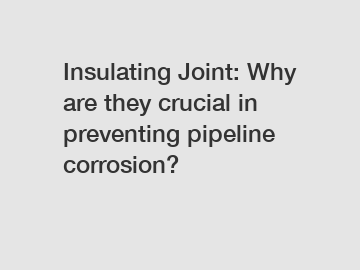Insulating Joint: Why are they crucial in preventing pipeline corrosion?
Insulating Joint: Why are they crucial in preventing pipeline corrosion?
Pipeline infrastructure plays a vital role in various industries, such as oil and gas transportation, to ensure the smooth flow of essential resources. However, pipelines are susceptible to corrosion due to the harsh environmental conditions they are exposed to. To mitigate this issue, insulating joints have emerged as an indispensable component in pipeline systems. In this article, we will delve into the importance of insulating joints and their significance in preventing pipeline corrosion.
Understanding Pipeline Corrosion.

Corrosion is a natural process that occurs when metal or metal alloys react with their environment. In the case of pipelines, corrosion can be caused by multiple factors, including moisture, oxygen, and impurities in the transported fluids. Corrosion can lead to significant damage, decreasing the structural integrity of pipelines and increasing the risk of leaks, ruptures, and environmental hazards. Preventing corrosion is crucial to ensure the longevity and reliability of pipelines, preserving the safety and integrity of the entire infrastructure.
The Role of Insulating Joints.
Insulating joints act as a reliable solution in preventing pipeline corrosion by isolating and electrically separating different sections of a pipeline. These devices are typically installed at strategic points, such as flange connections or junctions, where dissimilar metals or differing potentials exist. By creating an insulating barrier, insulating joints prevent the flow of electrical current between these sections, effectively eliminating one of the main causes of corrosion.
Preventing Galvanic Corrosion.
Galvanic corrosion occurs when two different metals come into contact in the presence of an electrolyte, such as moisture. This type of corrosion is prevalent in pipelines due to the variety of metals and alloys used in their construction. Insulating joints prevent galvanic corrosion by interrupting the electrical circuit formed between dissimilar metals. By isolating these metals electrically, the potential for corrosion caused by galvanic reactions is significantly reduced, extending the lifespan of the pipeline.
Mitigating Stray Current Corrosion.
Stray current corrosion is another common corrosion mechanism in pipelines, typically caused by electrical currents flowing in unintended paths through the infrastructure. Stray currents can be generated by various sources, including power transmission systems or cathodic protection systems. Insulating joints provide an effective solution to mitigate stray current corrosion by interrupting the flow of these unwanted electrical currents. By isolating different sections of the pipeline, insulating joints prevent stray currents from wreaking havoc and prolong the lifespan of the infrastructure.
Conclusion.
Insulating joints play a critical role in preventing pipeline corrosion, ensuring the longevity and integrity of these essential infrastructures. By isolating different sections of pipelines, insulating joints eliminate the main causes of corrosion, such as galvanic reactions and stray currents. Investing in high-quality insulating joints is a wise decision for pipeline operators to mitigate the risks associated with corrosion and maintain the efficiency and reliability of their systems.
For more information on the importance of insulating joints and their role in preventing corrosion, contact us today. Our team of experts is ready to provide guidance and solutions tailored to your specific needs. Protect your pipelines and guarantee their optimal performance by incorporating reliable insulating joints into your infrastructure.
If you are looking for more details, kindly visit thread flange, casing insulator, insulation joint gas pipeline.
110
0
0


Comments
All Comments (0)